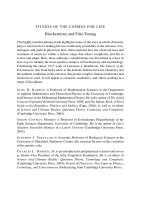life temperature and the earth
Bạn đang xem bản rút gọn của tài liệu. Xem và tải ngay bản đầy đủ của tài liệu tại đây (6.22 MB, 258 trang )
Ô
LIFE, TEMPERATURE, AND THE EARTH
This Page Intentionally Left Blank
Ô
LIFE, TEMPERATURE, AND THE EARTH
The Self-organizing Biosphere
David Schwartzman
Columbia University Press
Publishers Since 1893
New York Chichester, West Sussex
Copyright ᭧ 1999 Columbia University Press
All rights reserved
Library of Congress Cataloging-in-Publication Data
Schwartzman, David (David W.)
Life, temperature, and the earth : the self-organizing biosphere / David Schwartzman.
p. cm.—
Includes bibliographical references.
ISBN 0-231-10212-7 (alk. paper)
1. Biosphere. 2. Bioclimatology. 3. Weathering. I.Title.
II.Series.
QH343.4.S36 1999
577.2Ј2—dc21 99-25856
∞
Casebound editions of Columbia University Press books
are printed on permanent and durable acid-free paper.
Printed in the United States of America
c10987654321
To my sons, Sam and Peter; my father, Max; and the four who inspired
whatever value is contained in this book: Jim Lovelock, Lynn Margulis,
Vladimir Vernadsky, and Fred Engels
This Page Intentionally Left Blank
Ô
CONTENTS
Acknowledgments ix
Introduction: A Personal Note xi
1: Climatic Evolution: From Homeostatic Gaia to Geophysiology 1
2: The Biogeochemical Cycle of Carbon 15
3: Faint Young Sun Paradox and Climate Stabilization 32
4: Weathering and Its Biotic Enhancement 43
5: Weathering: From Theory and Experiment to the Field 66
6: Quantifying the Biotic Enhancement of Weathering and Its Implications 80
7: Surface Temperature History of the Earth 99
8: Did Surface Temperatures Constrain Microbial Evolution? 119
9: Self-organization of the Biosphere 157
10: Alien Biospheres? 179
11: Conclusions 191
References 197
Index 239
This Page Intentionally Left Blank
Ô
ACKNOWLEDGMENTS
The author acknowledges the close collaboration of Tyler Volk, Mark
McMenamin, Mike Rampino, Ken Caldeira, and Steve Shore, along with
the help and patient advice of Connie Barlow, Scott Bailey, Bob Berner,
Susan Brantley, Ford Cochran, Paula DePriest, Dave Des Marais, Tim
Drever, Sam Epstein, Jack Farmer, Bruno Giletti, Peter Gogarten, John
Grotzinger, David Hawksworth, Marti Hoffert, Dick Holland, Togwell
Jackson, Annika Johansson, Jim Kasting, Lee Klinger, Paul Knauth, Lee
Kump, Jim Lawrey, Franz May, Euan Nisbet, Verne Oberbeck, Greg Retal-
lack, Norrie Robbins, Mike Russell, Peter Schultz, Paul Shand, Rod Swen-
son, Bill Ullman, Peter Westbroek, Art White, and my colleagues at How-
ard University.
This Page Intentionally Left Blank
Ô
INTRODUCTION: A PERSONAL NOTE
At the age of 12 or 13, I read a J. B. S. Haldane book on the natural sciences,
which I discovered in my uncle’s library. Haldane mentioned some of the
Russian work on the biological role in weathering (probably Polynov or one
of his students). I had forgotten about all this until I became interested in this
subject again as an adult. I have not yet found the Haldane volume men-
tioned, but those early researchers felt, doubtlessly influenced by Vernadsky’s
thinking on the subject, that weathering was basically a biological phenome-
non and would be much slower without life present. Having grown up in
an “old left” household in the 1950s in Brooklyn, I discovered the Marxist
classics in a hidden space below the family television. Reading Engels’s Dia-
lectics of Nature strongly impressed me. Burning the top of my dresser with
chemistry experiments and collecting minerals, insects, and plants occupied
my childhood. I probably passed Stephen Jay Gould on my monthly pilgrim-
age to the mineral hall at the Museum of Natural History (the dinosaur ex-
hibit was on the way). I majored in chemistry at Stuyvesant High School and
geochemistry at City College of New York and Brown University, where
my graduate research was on excess argon in the Stillwater Complex and de-
gassing models of the Earth. I did a term paper on Vernadsky and biogeo-
chemistry as a senior in Alexander Klots’s (the author of A Field Guideto Butter-
flies) biology class in the spring of 1964.
This book is an outgrowth of research that I have been pursuing for the
past 15 years, since I first felt the powerful heuristic influence of Lovelock’s
1979 book on Gaia. The concept of Gaia strongly resonated with my sense
that spheres of nature interacted dialectically in the Engelsian sense, that is,
emergent phenomena arise from the interactions of the parts (the whole’s
systems and subsystems; for a lucid exposition of a modern dialectics of na-
ture, see Levins and Lewontin 1985). The whole, Gaia, evolves as the parts
(organisms and ecosystems) themselves evolve. The Gaian interactions to be
discussed in this book include those among life, climate, weathering, hydrol-
ogy, and crustal/impact history. This book will present in a systematic way
the developing theory for a biotically mediated regulation of Earth’s temper-
ature over geologic time, the first order determination of the history of cli-
mate. The emphasis is on long-term geologic trends, not the short-term per-
turbations that have received so much media attention (e.g., the anthro-
pogenic greenhouse effect).
The first third of the book (chapters 1–3) will introduce my theory of
biospheric evolution followed by the Gaia concept and its evolution in the
1980s and 1990s. The biogeochemical cycle of carbon and the silicate-
carbonate climatic stabilizer will then be discussed. This stabilizer entails the
dependence of the chemical weathering rate (the sink for atmospheric car-
bon dioxide) on global temperature. A key question raised here is the crit-
icality of life to the operation of the stabilizer. Is climatic stabilization an
emergent property of the Earth’s biosphere, in the context of changing solar
luminosity and other abiotic factors?
The second third (chapters 4–6) will present a systematic exposition of
the weathering process, including recent research on its biotic enhancement,
and a model for understanding the habitability of the Earth over geologic
time. The evidence for biotic enhancement of weathering includes experi-
mental and field studies that need to be significantly expanded. This section
will include discussion of the abiotic factors affecting climatic evolution, such
as tectonics and the carbon geodynamic cycle, as well as their possible bi-
otic mediation.
The last third of the book (chapters 7–11) will present a reinterpretation
of the surface temperature history of the Earth. A much warmer Precambrian
Earth surface is supported by a diverse body of evidence, implying a high
present biotic enhancement of weathering consistent with our earlier esti-
mates (two orders of magnitude, though probably not three). A geophysio-
logical theory of the coevolution of life and the biosphere itself, entailing a
progressively changing biotic enhancement of weathering, will be presented.
The implications of these results to evolutionary biology and to bioastron-
omy (the search for life elsewhere in the universe) and a theory of the self-
organization of the Earth’s biosphere will be discussed. One startling conclu-
INTRODUCTION xii
sion emerges: microbial evolution in the Precambrian was constrained by
the surface temperature, indicating that the major events in biotic evolution
were forced by the physical context for self-organization. A concluding chap-
ter will summarize the main conclusions and raise a research agenda for di-
verse fields of science ranging from geochemistry to biology.
I NTR O D U CT IO N xiii
This Page Intentionally Left Blank
Ô
LIFE, TEMPERATURE, AND THE EARTH
This Page Intentionally Left Blank
Ô
1 CLIMATIC EVOLUTION: FROM HOMEOSTATIC GAIA
TO GEOPHYSIOLOGY
A theory of biospheric evolution. Coevolution of climate and life (precursors: co-
evolution as life adapting to changing climate; Preston Cloud: oxygen and life;
Schneider and Londer: anthropogenic effects on climate) A brief history of the Gaia
concept: Lovelock’s early papers, Doolittle’s challenge, DaisyWorld, the AGU Gaia
Conference, 1988. A Gaian mechanism on today’s Earth? (DMS and cloud formation
over the ocean, a climatic stabilizer?)
A Theory of Biospheric Evolution
I begin with a brief outline of my theory of how our biosphere has evolved
since the origin of life some 4 billion years ago. This theory is a provocation:
to think about the evolution of life and climate in a new way. Both the begin-
ning and end of life on this planet are determined by purely nonbiological
conditions, the beginning by the hydrothermal activity on the ocean floor,
where the origin of life took place, the end by the rising radiant energy
flux from the sun. But between these times, predetermined by the initial
conditions of our solar system, the biosphere evolves in its overall patterns
deterministically, going from a hothouse with surface temperatures near
100°C to an icehouse, with intermittent glacial periods, then in the future
back into a hothouse regime before its destruction. A progressive increase in
the diversity of habitats for life and a concomitant biotic evolutionary explo-
sion has occurred in the past 4 billion years, only to be reversed in the future
with a return to the hothouse.
The surface temperature scenario argued for in this book is shown in fig-
ure 1-1. Now for a key concept in this theory of biospheric evolution. Sur-
face temperature is a critical constraint on the tempo of major events in biotic
evolution, while it is determined itself by a progressively increasing role of
biota in climatic change over geologic time, within the context of abiotic
evolution (solar and terrestrial). The temperature constraint has occurred be-
cause each major innovation in biological evolution, such as oxygenic pho-
tosynthesis (emergence of cyanobacteria), has an inherent biochemical and
biophysical upper temperature limit for its metabolism. Thus, with the long-
term cooling of the Earth’s surface, new metabolisms and cell types became
possible as their upper temperature limit was reached. Cooling occurred be-
cause of the combined effects of abiotic variations, such as volcanic outgas-
sing rates and rising solar luminosity, and the progressively powerful effect of
land biota on the sequestering of carbon from the atmosphere by the chemi-
cal weathering process in soils. As a result, carbon dioxide levels in the atmo-
sphere have dramatically declined since the origin of life, declined enough
to have decreased surface temperatures from near 100°C to the present
globalmeanof15°C, despite the rising solar energy flux. Where did this
carbon dioxide go? Some was probably recirculated down into the mantle,
CLIMACTIC EVOLUTION 2
-.
Surface temperature history of Earth as argued for in this book. Surface temperatures
(°C) versus time BP (billion years). Negative time corresponds to the future.
but the crust now contains the equivalent of some 60 times the total pressure
of the atmosphere, in the form of limestone and marble (calcium carbonate),
which was sequestered from atmosphere.
The biosphere has evolved deterministically as a self-organized system,
given the initial conditions of the sun-Earth system. The origin of life and
the overall patterns of biotic evolution were highly probable outcomes of
this deterministic process. These overall patterns include the emergence of
oxygenic photosynthesis and the history of endosymbiogenesis, which re-
sulted in the emergence of Eukarya (complex life) and its kingdoms. Evolu-
tion of procaryotes and complex life on terrestrial planets around sunlike stars
are expected to have similar geochemical and climatic consequences. Thus,
the main patterns would be conserved if “the tape were played twice,” a
theory argued from computer simulations by Fontana and Buss (1994). The
width of the habitable zone for Earth-like planets around sunlike stars for
complex life may be substantially smaller than that for the appearance of
biota, constrained by the presence of liquid water. Surface temperature his-
tory on terrestrial planets may be critical to the time needed to evolve com-
plex life and intelligence. Biotically mediated cooling increases the width of
the habitable zone for the possible occurrence and evolutionary time frame
of complex life. For Earth-like planets within the habitable zone of stars less
massive than the sun, the earlier emergence of complex life is expected, all
other factors being the same.
This is a brief summary of my theory, which grew out of collaborative
research, first of all with Tyler Volk, and the input of a vast literature. The
rest of this book will explore step by step the science behind this theory,
starting in the next chapter with the biogeochemical cycle of carbon, which
determines at any time the level of carbon dioxide in the atmosphere and
the surface temperature. But first a historical overview of theories of the
coevolution of life and its environment (the most common definition of the
biosphere) is needed. The Gaia concept and its development figure promi-
nently in this history. We begin with Gaia for two reasons: first, its historical
importance in the development of coevolutionary theory; and second, the
Gaia theory has had a profound heuristic influence on a global network of
scientists from many disciplines, including myself (Schneider and Boston
1991). Gaia theory has stimulated an expanding wave of research into the
coupling of life and its environment, paradoxically despite and because of its
impurity and metaphorical excursions.
CLIMACTIC EVOLUTION 3
Coevolution of Climate and Life
Although all researchers accepting the scientific paradigm agree that life has
indeed evolved over geologic time, there is still debate and some uncertainty
as to whether climate did also, particularly in the strong sense of some direc-
tional vector, a mode that is certainly debatable with respect to biological
evolution. The temperature record of the past billion years supports fluctua-
tions of some 5 to 10°C from the present mean global surface value of 15°C,
but the interpretation of the more ancient record, back to 4 billion years ago
(4 Gigayears [Ga]) is more confused, with some researchers supporting a
nearly constant temperature, and others a strong cooling to present. How-
ever, one aspect of climate has almost certainly changed over the past 4 billion
years—atmospheric composition, particularly the oxygen level.
The geologic/geochemical record generally supports low to exceedingly
low atmospheric pO
2
levels prior to about 2.2 Ga, with modern levels of
some 0.2 bar being approached in the Phanerozoic. This evidence includes
the presence of minerals deposited on the surface prior to about 1.8 Ga that
are unstable in free oxygen, abundant “red beds” later than this date, and
inferences based on the variation in oxidation state of iron in ancient soils
(paleosols) of different ages (Holland 1994).
This evidence deserves closer attention. First, detrital (grains deposited by
surface water) uraninite (UO
2
) is found in large deposits with ages older than
2.3 Ga. Uraninite quickly oxidizes in the presence of free oxygen. Abundant
red beds (sediments with iron in the oxidized ferric state) only appear in the
geologic record by 2.3 to 2.4 Ga. Finally, paleosols from before 2.2 Ga show
apparent primary leaching of iron, indicating low atmospheric oxygen levels
because ferrous, not ferric, iron is easily dissolved in ground water. Paleosols
from after 1.8 Ga have oxidized iron. Based on this evidence, Holland (1994)
postulated that atmospheric oxygen rose significantly from 2.2 to 1.9 Ga.
From their study of the kinetics of calcium carbonate precipitation and its
influence on the textures of carbonate rocks of Precambrian age, Sumner
and Grotzinger (1996) concluded that high concentrations of ferrous iron
were present in the Archean ocean, only possible with low oxygen levels,
with ferrous iron levels declining and oxygen rising in the atmosphere at
2.2 to 1.9 Ga. This scenario is based on their observation that ferrous iron in-
hibits calcite precipitation, which would result in microcrystalline textures,
CLIMACTIC EVOLUTION 4
while apparently allowing the precipitation of the fibrous herringbone cal-
cite found abundantly in Archean carbonates.
There are, however, dissenting voices to this scenario. Towe (1994) has
long argued for the presence of modest levels of oxygen in the Archean
atmosphere (3.8 to 2.5 Ga) in contrast to the more commonly held view of
geochemists and paleoclimatologists that levels then were exceedingly low
(Kasting 1987). An even more radical challenge has come from Ohmoto
(1996, 1997a, 1997b) who has looked closely at the paleosol record, con-
cluding that both oxidized and reduced primary iron occurs in the record
both before and after 2.2 Ga. He argues for a comparable oxygen level in the
2.2 to 3.0 Ga atmosphere to the present atmospheric level (PAL). Because
the other body of evidence seems to support Holland’s scenario (Holland
and Rye 1997), it is not clear at this point how reliable the paleosol evidence
really is, given the possibilities for alteration of the original weathering im-
print in the past 2 billion years or more.
On the basis of an inferred variation in atmospheric pO
2
levels, Preston
Cloud (1976) argued for atmospheric oxygen being a constraint on biotic
evolution, with the emergence of first eucaryotes and then Metazoa linked
to progressive increases in the levels of atmospheric oxygen. Cloud argued
that at least 1% PAL free oxygen was needed for eucaryote (mitochondrial)
metabolism, still higher levels for megascopic algal and metazoan forms that
exchange gases by diffusion. Finally, larger skeletonized Metazoa and land
plants require near modern levels. Of course, a feedback from life to atmo-
spheric composition is also required, the generation of oxygen by photo-
synthesis coupled with burial of organic carbon. Others have highlighted
climate/life coevolution, but restricting this linkage to recent times (e.g.,
Schneider and Londer 1984, pointing out Pleistocene glacial/interglacial
cycles and anthropogenic effects on climate).
Gaia
A much more radical conception of coevolution was put forward by James
Lovelock, an atmospheric chemist, soon joined by Lynn Margulis (the biolo-
gist best known for her theory of endosymbiogenesis), namely the Gaia hy-
pothesis. Gaia is not a rephrasing of “coevolution”: “Coevolution is rather
like a platonic friendship. The biologist and the geologist remain friends but
CLIMACTIC EVOLUTION 5
never move on to an intimate, closely coupled relationship. Coevolution
theory includes no active regulation of the chemical composition and climate
of the Earth by the system comprising the biota and their material environ-
ment” (Lovelock 1989). What Lovelock is arguing here is that the classical
view of coevolution of climate and life does not capture the richness of inter-
active processes and feedbacks, nor does it recognize that planetary biota
actively determines its planetary environment. But Lovelock goes even fur-
ther asserting that in some sense the Earth (surface) is living, with its own
physiology, a geophysiology of a superorganism. Homeostasis is a character-
istic of animal metabolism. Biotic regulation of its global external environ-
ment leading to, for example, stable climate is for Lovelock homeostasis on
a planetary scale.
One of the most famous Gaian metaphors is the “living Earth” ( just how
metaphorical or literal depends on the text one reads). The Earth as a super-
organism resonates with Hutton’s conception. This 18th-century Scottish
doctor, farmer, and arguably the founder of modern geology, did his thesis
entitled “The Blood and Circulation in the Microcosm,” drawing back from
the medieval conception of the macrocosm and microcosm (Adams 1954).
Huttonwrote,“Weare thusledtoseeacirculation in the matter of the
globe, and a system of beautiful economy in the works of nature. This earth,
like the body of an animal, is wasted at the same time that it is repaired”
(quoted in McIntyre 1963). Hutton’s equivalent of blood in the circulation
of the Earth was water.
Much has been written about the origin of the Gaia hypothesis. Love-
lock’s own account is the most eloquent (Lovelock 1979). Briefly, Lovelock,
working at the Jet Propulsion Laboratory in the 1960s, concluded that the
atmospheric composition of Mars should be indicative of the presence or
absence of life. Several constituents in the Earth’s atmosphere, particularly
oxygen and methane, are not in equilibrium with its crust, with measured
fluxes being dramatically different from those expected on an abiotic Earth
(figure 1-2). Thus, he concluded that any disequilibrium of Mars’ atmo-
sphere with its crust should be strong evidence for life (as it turned out, Mars’
atmosphere is apparently close to chemical equilibrium with its crust, consis-
tent with the present absence of a living surface biota, and the hegemonic
consensus from the results of the Viking biology experiments; Gilbert Levin,
the principal investigator for the labeled release experiment, has been one
continuing dissenter).
CLIMACTIC EVOLUTION 6
Lovelock’s insight led to a radically new explanation of Earth’s habitability
for the past 3 billion years (now accepted to be at least 3.5 billion years based
on fossil evidence). This habitability was not just “dumb luck,” but rather
a result of continuous biotic interaction with the other components of the
biosphere, the atmosphere, ocean, and soil/upper crust. The requirements
of habitability include favorable temperatures, ocean salinity, and—at least
for the past 2 billion years—atmospheric oxygen levels for aerobes. In Love-
lock and Margulis’s early papers, we find a formulation of Gaia as a homeo-
static system:
From the fossil record it can be deduced that stable optimal conditions
for the biosphere have prevailed for thousands of millions of years. We
believe that these properties of the terrestrial atmosphere are best inter-
preted as evidence of homeostasis on a planetary scale maintained by
life on the surface (Lovelock and Margulis 1974a).
The notion of the biosphere as an active adaptive control system
CLIMACTIC EVOLUTION 7
-.
The fluxes of gases to the present atmosphere compared with those expected for an
abiotic Earth (after Lovelock 1989).
Image Not Available
able to maintain the earth in homeostasis we are calling the Gaia Hy-
pothesis (Lovelock and Margulis 1974b).
What are optimal conditions? Optimal for maximum productivity of ecosys-
tems, the global biota? Optimal for the persistence of planetary biota, but
which components? Is optimality to be measured in number of species? (If
so, on the present Earth beetles apparently win out.) Did the anaerobic pro-
caryotes of the Archean optimize atmospheric conditions for their succes-
sors, the aerobes? Optimality is a problematic concept at the very least.
After the publication of Lovelock’s first book (1979), homeostatic Gaia
came under heavy attack in the 1980s primarily from staunch neodarwinian
biologists (Doolittle 1981, Dawkins 1982, Maynard Smith 1988). They ob-
jected to the concept of life optimizing its external conditions by natural
selection because the biosphere is a single entity “competing” against no
other (see discussion in Barlow and Volk 1992a). Furthermore, “Gaia, as a
cybernetic system, must have mechanisms for sensing when global physical
and chemical parameters deviate from optimum, and mechanisms for initiat-
ing compensatory processes which will return those parameters to acceptable
values (negative feedback)” (Doolittle 1981).
In response to such criticism, Watson and Lovelock (1983) developed the
Daisyworld model, an attempt to demonstrate the possibility of planetary
surface homeostasis without invoking natural selection. This model in its
simplest form assumes dark and light daisies populating a planet, subject to a
steadily rising energy flux from outside (as the Earth/sun couple). The daisies
differ only in their reflectivity (albedo) of incoming radiation, with the same
growth and death rates. The result is that the planetary temperature signifi-
cantly stabilizes as the incoming energy flux increases, an outcome of the
“thermostat” set up by the successive expansion of first dark then light dai-
sies, each affecting the planetary albedo (figure 1-3). Lovelock (1989) and
others (Saunders 1994) have followed up this original model by making the
“ecosystem” more complex (e.g., adding predators, shades of daisies) and
more realistic controls on heat flow between regions on the hypothetical
planet Daisyworld. The model results appear to strengthen the hypothesis
that homeostasis, at least by albedo modification, would result from plausible
biotic physiology, without natural selection operating to guarantee optimi-
zation.
CLIMACTIC EVOLUTION 8









